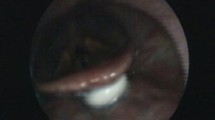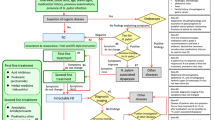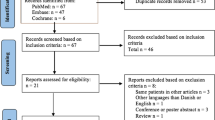Abstract
Smooth-muscle specimens from the lower esophagus of nine patients operated on for esophageal achalasia were examined with routine hematoxylin-eosin staining. This procedure revealed only a few eosinophils in or between the external smooth-muscle layers. Using specific immunohistochemical methods for the detection of the eosinophil cationic protein (ECP), however, varying degrees of eosinophil infiltration and extracellular deposit of ECP were disclosed in the achalasia specimens. The ECP also reacted with the monoclonal antibody, EG2, indicating secretion of the cytotoxic ECP. Few or no eosinophils were seen in the muscularis externa in specimens from six control patients without esophageal disease. In two controls many eosinophils were observed in the muscularis externa. However, no extracellular ECP was detected and very few eosinophils reacted with the monoclonal antibody (EG2), suggesting that these eosinophils were not activated. Depletion or total absence of peptidergic innervation was seen in all achalasia specimens but not in controls. Since the eosinophil cationic protein (ECP), in its activated form, is cytotoxic, we propose a pathogenic role of the eosinophil infiltration in achalasia.
Similar content being viewed by others
References
Castell DO: Achalasia and diffuse esophageal spasm. Arch Intern Med 136:571–579, 1976
Cross FS: Pathologic changes in megaesophagus (esophageal dystonia). Surgery 31:647–653, 1952
Cassela RR, Brown AL, Sayre GP, Ellis FH: Achalasia of the esophagus: Pathologic and etiologic considerations. Ann Surg 160:474–486, 1964
Cassela RR, Ellis FH, Brown AL: Fine structure changes in achalasia of the esophagus. II. Esophageal smooth muscle. Am J Pathol 46:467–475, 1965
Misiewicz JJ, Waller SL, Anthony PP, Gummer JWP: Achalasia of the cardia: Pharmacology and histopathology of isolated cardiac sphincteric muscle from patients with and without achalasia. Q J Med 149:17–30, 1969
Lendrum FC: Anatomic features of the cardiac orifice of the stomach with special reference to cardiospasm. Arch Intern Med 59:474–511, 1937
Smith B: The neurological lesion in achalasia of the cardia. Gut 11:388–391, 1970
Trounce JR, Deuchar DC, Kauntze R, Thomas GA: Studies in achalasia of the cardia. Q J Med 104:433–443, 1957
Csendes A, Smok G, Braghetto I, Ramirez C, Velasco N, Henriques A: Gastroesophageal sphincter pressure and histological changes in distal esophagus in patients with achalasia of the esophagus. Dig Dis Sci 30:941–945, 1985
Qualman SJ, Haupt HM, Yang P, Hamilton SR: Esophageal Lewy bodies associated with ganglion cell loss in achalasia. Gastroenterology 87:848–856, 1984
Waller SL, Misiewicz JJ, Anthony PP, Gummer JWP:In vitro pharmacologic and histopathologic studies on the human cardiac sphincter muscle from achalasic and control patients. Am J Dig Dis 16:566–568, 1971
Aggestrup S, Uddmann R, Sundler F, Fahrenkrug J, Haakanson R, Sorensen HR, Hambraeus G: Lack of vasoactive intestinal polypeptide nerves in esophageal achalasia. Gastroenterology 84:924–927, 1983
Landres RT, Kuster GGR, Strum WB: Eosinophilic esophagitis in a patient with vigorous achalasia. Gastroenterology 74:1298–1301, 1978
Fredens K, Tøttrup A, Kristensen IB, Dahl R, Jacobsen NO, Funch-Jensen P, Thommesen P: Severe destruction of esophageal nerves in a patient with achalasia secondary to gastric carcinoma: A possible role of eosinophil neurotoxic proteins. Dig Dis Sci 34:297–303, 1989
Gleich GJ, Frigas E, Loegering DA, Wassom DL, Steinmuller D: Cytotoxic properties of the eosinophil major basic protein. J Immunol 123:2925–2927, 1979
Fredens K, Dahl R, Venge P: The Gordon phenomenon induced by the eosinophil cationic protein and eosinophil protein X. J Allergy Clin Immunol 70:361–366, 1982
Fredens K, Dahl R, Venge P: Eosinophils and cellular injury: The Gordon phenomenon as a model. NER Allergy Proc 6:346–350, 1985
Tai P-C, Spry CJF, Peterson C, Venge P, Olsson I: Monoclonal antibodies distinguish between storage and secreted forms of eosinophil cationic protein. Nature 309:182–184, 1984
Sternberger LA: Immunocytochemistry. New York, John Wiley & Sons, 1979
Fredens K, Dybdahl H, Dahl R, Baandrup U: Extracellular deposits of the cationic proteins ECP and EPX in tissue infiltrations of eosinophils related to tissue damage. APMIS 96:711–719, 1988
Cassela RR, Ellis FH, Brown AL: Fine structure changes in achalasia of the esophagus. I. Vagus nerves. Am J Pathol 46:279–288, 1965
Friesen DL, Henderson RD, Hanna W: Ultrastructure of the esophageal muscle in achalasia and diffuse esophageal spasm. Am J Clin Pathol 79:319–325, 1983
Harman JW, O'Hegarty MT, Byrnes CK: The ultrastructure of human smooth muscle. I. Studies on cell surfaces and connections in normal and achalasia esophageal smooth muscle. Exp Mol Pathol 1:204–228, 1962
Kierszenbaum F, Villalta F, Tai PC: Role of inflammatory cells in Chagas' disease. III. Kinetics of human eosinophil activation upon interaction with parasites (Trypanozoma cruzi). J Immunol 136:662–666, 1986
Köberle F: Megaesophagus. Gastroenterology 34:460–466, 1958
Caldwell JH, Mekhjian HS, Hurtubise PE, Beman FM: Eosinophil gastroenteritis with obstruction: Immunological studies of seven patients. Gastroenterology 74:825–828, 1978
Aggestrup S, Uddman R, Jensen SL, Sundler F, Schaffalitzky de Muckadell O, Holst JJ, Håkanson R, Ekman R, Sørensen HR: Regulatory peptides in the lower esophageal sphincter of man. Regul Pept 10:167–178, 1985
Aggestrup S, Emson P, Uddman R, Sundler F, Jensen SL, Sørensen HR: Distribution and content of neuropeptide Y in the human lower esophageal sphincter. Digestion 36:68–73, 1987
Holloway RH, Dodds WJ, Helm JF, Hogan WJ, Dent J, Arndorfer RC: Integrity of cholinergic innervation to the lower esophageal sphincter in achalasia. Gastroenterology 90:924–929, 1986
Author information
Authors and Affiliations
Rights and permissions
About this article
Cite this article
Tøttrup, A., Fredens, K., Funch-Jensen, P. et al. Eosinophil infiltration in primary esophageal achalasia. Digest Dis Sci 34, 1894–1899 (1989). https://doi.org/10.1007/BF01536708
Received:
Revised:
Accepted:
Issue Date:
DOI: https://doi.org/10.1007/BF01536708




